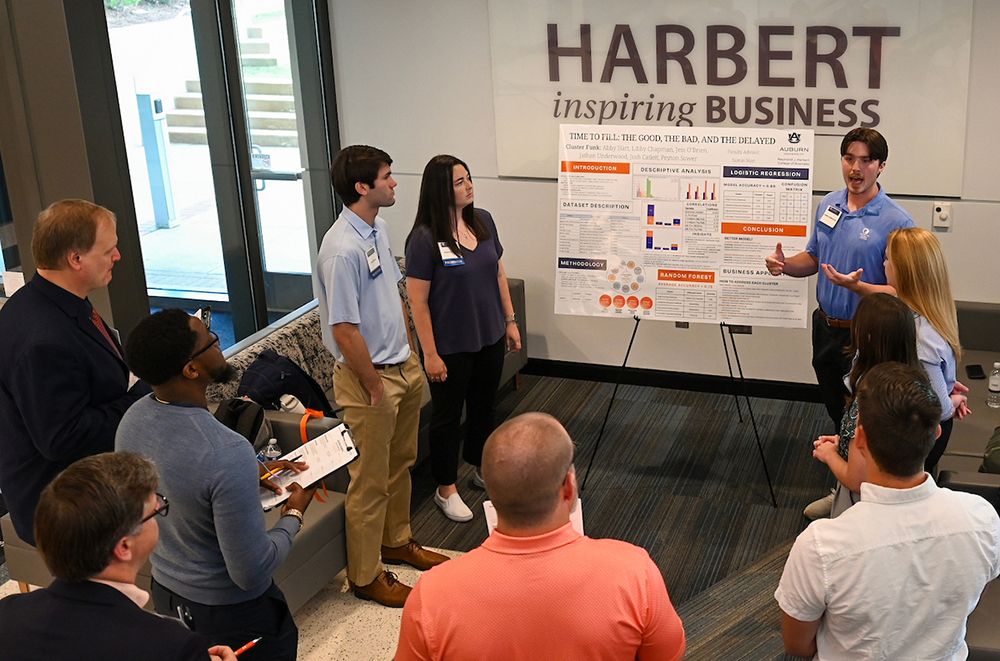Auburn researchers' new machine learning-based method highlights the importance of
algorithmic approaches for addressing class imbalance and supporting theory testing.
A team of Harbert College of Business researchers have developed a novel algorithmic
approach for handling imbalanced data sets—a common occurrence in predictive analytics—and
they aim to apply the method to the world of mergers and acquisitions (M&A).
Predictive analytics tools allow businesses to make data-driven decisions, mitigate
potential risks, and increase the odds of a successful M&A deal.
 |
Harbert faculty Kangbok Lee (left) and Sumin Han
|
As a point of reference, management consulting firm Bain & Company reported that the
value of M&A deals globally was more than $3 trillion in 2023.
Business Analytics faculty members Kangbok Lee and Sumin Han created the method with former Auburn doctoral student Yeasung Jeong, who is now a faculty member at the State University of New York at Albany, and Young Woong Park, an assistant professor at Iowa State University.
According to Lee, their method, which they call the systemic approach for imbalanced
learning, may someday be used to predict whether an announced corporate M&A will successfully
result in a deal.
“We examined whether the acquiring and target firms indeed merged after the deal was
announced,” said Lee, the EBSCO associate professor of business analytics. “Completing
the deal is crucial for stakeholders like merger arbitrageurs, target shareholders
and acquiring firms. Their primary interest lies in predicting whether a deal will
go through to effectively manage financial risks and opportunities.”
These deals can fail for various reasons—shareholders get cold feet and vote against
the deal, another company steps in with a better offer, or regulatory issues prohibit
the deal, for example. But the bottom line is investors would like to be able to predict
whether a deal will close because a failed M&A will affect the reputation and stock
price of the companies involved.
 |
Adobe Stock. AI-generated image
|
A nature-inspired algorithm
The algorithm-based model that Lee and his colleagues developed to predict M&A success
was inspired by nature.
“Our systemic approach for an imbalanced learning algorithm is inspired by the survival
story of sea turtle hatchlings,” Lee explained. “Many hatchlings die on the beach
due to predators, but once they enter the ocean their survival chances dramatically
go up."
Lee and his colleagues applied this two-stage scenario—beach and sea—to M&A by creating
an automated algorithm that contains two latent equations—a split probit equation
in the first stage and an ordinary logit equation in the second stage.
“In the first stage of the M&A survival story, completed cases are primarily influenced
by M&A-related predictors, as highlighted in the literature,” Lee said. “Hostile deals
often encounter resistance from target firms, making non-hostile deals more likely
to succeed, while tender offers signal confidence in the transaction. We also considered
factors like the relative risk between acquirer and target firms and pre-announcement
increases in the target firm’s share price, which can reduce the likelihood of bid
competition and price revision.”
In the second stage, financial predictors play a significant role in M&A deal that
fail to go through.
“We analyzed financial characteristics of both acquirer and target firms, including
dividend per share, inventory-to-total-assets ratio, market-to-book ratio, price-to-earnings
ratio, sales growth rate, capital expenditure-to-operating revenue ratio, invested
capital turnover, dividend yield, and total assets logarithm,” he said.
Conventional prediction methods, in contrast, typically include both success and failure
outcomes of an M&A deal in a single binary equation, Lee said.
“This means that the same set of factors is used to predict both success and failure
simultaneously, which may limit the accuracy of the model by treating the two outcomes
as driven by the same underlying dynamics,” he added. “In contrast, our approach separates
the distinct outcomes into two equations—one equation focuses on explaining the factors
leading to successful deals, while the other explains the factors contributing to
failed deals.”
According to Lee, their experimental results show that their automated proposed algorithm
yields better predictive accuracy compared to other leading algorithms.
“Given that our approach highlights the crucial importance of accounting for class
imbalance in M&A data to ensure accurate empirical analysis, it is clear that future
research must integrate advanced methods, such as algorithmic approaches, to effectively
address this issue in theory testing,” Lee said. “Traditional logit or probit models,
while useful, are insufficient for testing hypotheses and capturing the complexities
inherent in imbalanced datasets. As such, the adoption of more sophisticated techniques,
like the two-regime process combined with boosting, is essential for producing more
reliable and accurate theory testing in M&A research.”
Lee published his results and the algorithm in Machine Learning, a highly regarded peer-reviewed scientific journal primarily read by computer science
researchers. He and his colleagues also introduced algorithmic approaches for causal
inference in Pattern Recognition, a highly respected peer-reviewed journal in computer science.
They are currently working on a follow-up research paper detailing their algorithm-based
approach, which is currently under revision for the Journal of Operations Management, a leading business journal.
###

 Degrees & Programs
Degrees & Programs
 Faculty & Staff
Faculty & Staff
 Career Development
Career Development
 Recruiters & Industry
Recruiters & Industry




